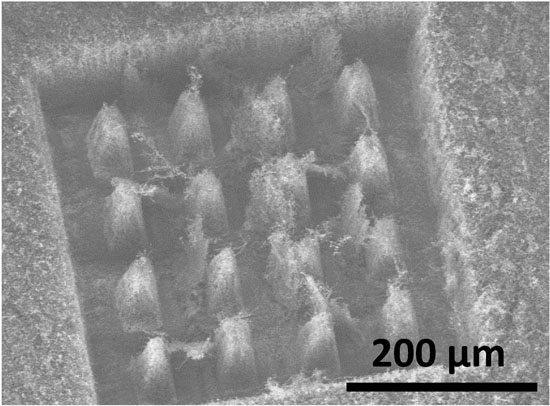Multifunctional Material Structures Based on Laser-Etched Carbon Nanotube Arrays
Abstract
:1. Introduction
2. Experimental Section
2.1. CNT Brush Processing
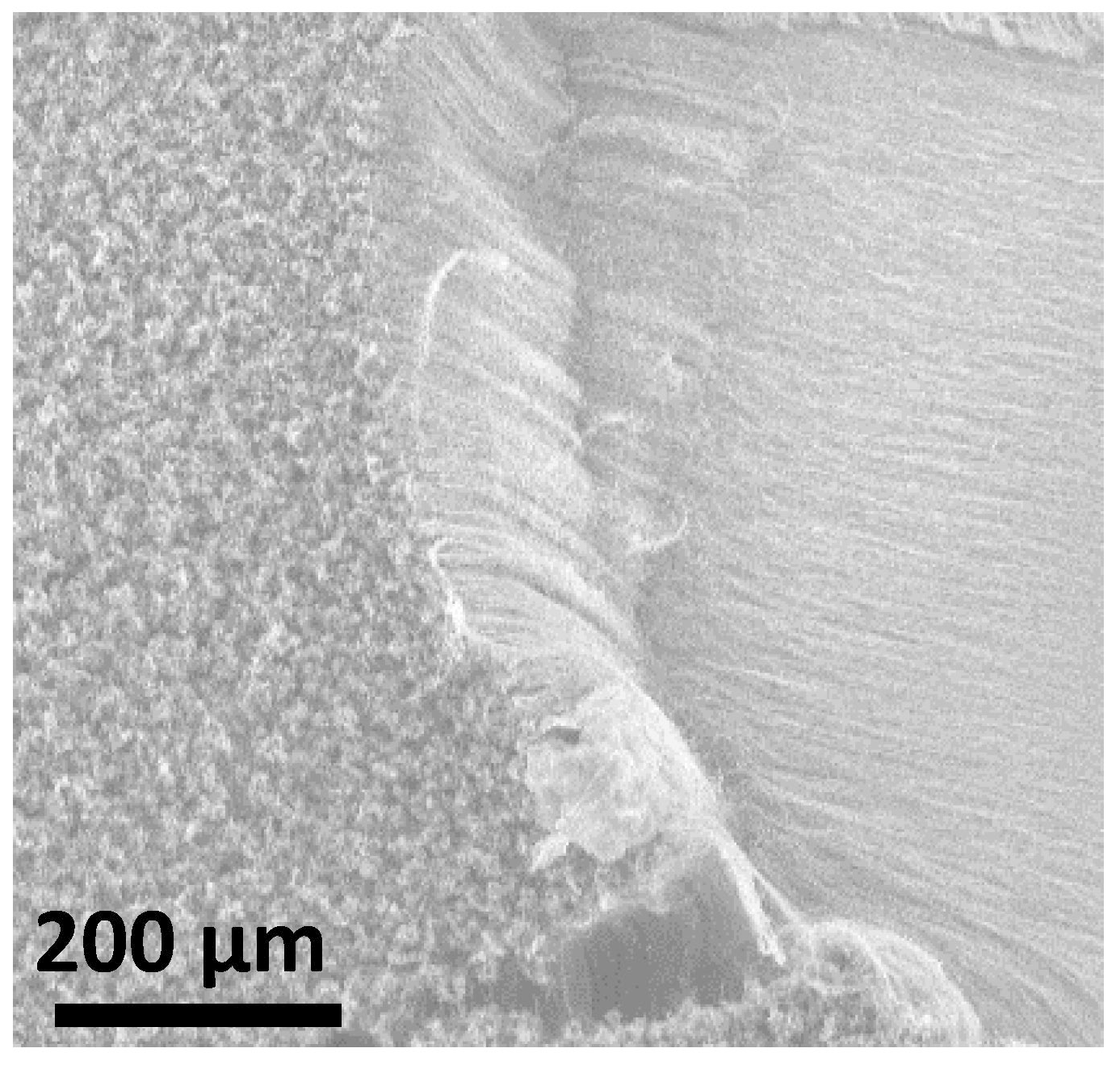
2.2. Laser Processing
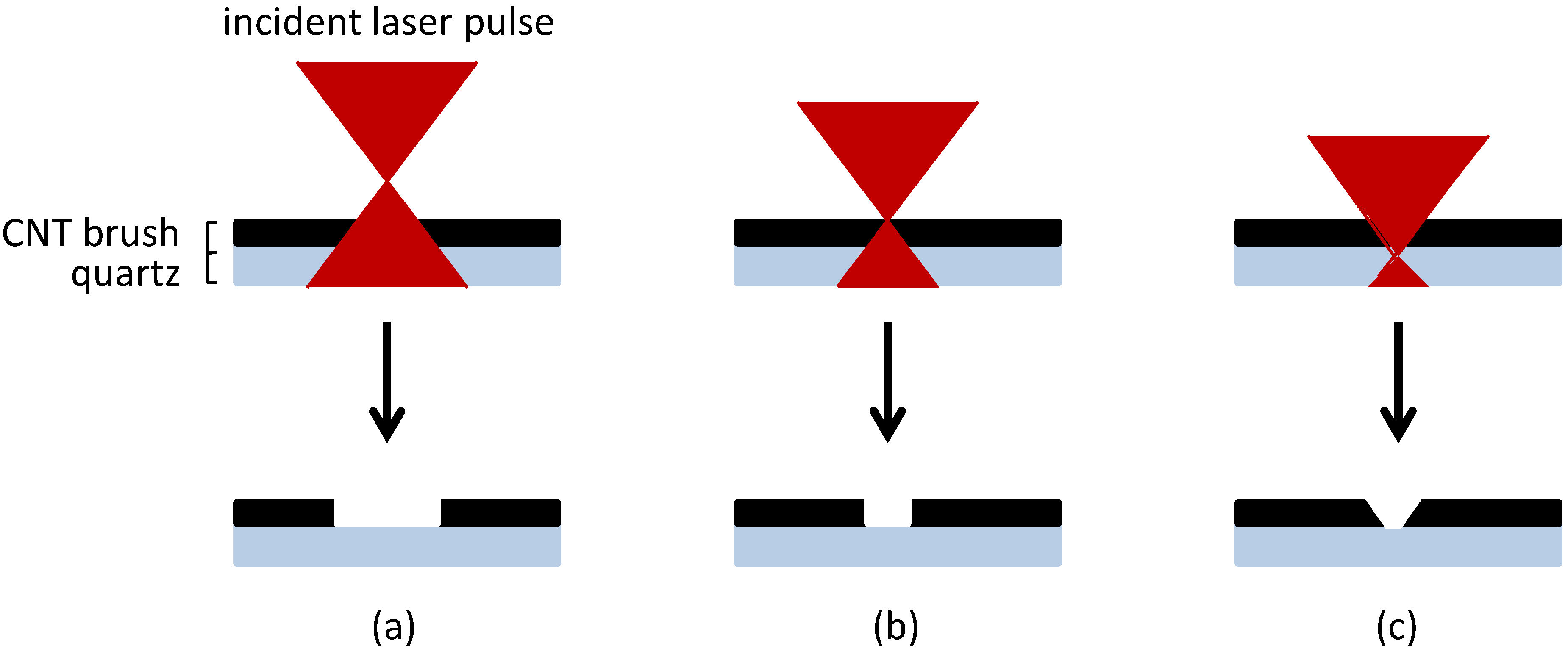
| Pattern | Spot size expected (µm × µm) | Average power (mW) | Offset focus (µm) | Scan repetitions | Scan rate (mm/s) | Pulse frequency (kHz) |
|---|---|---|---|---|---|---|
| Pattern 1 | 100 × 100 | 146 | 0 | 15 | 50 | 100 |
| Pattern 2 | 100 × 100 | 310 | Positive | 15 | 50 | 100 |
| Pattern 3 | 100 × 100 | 310 | 700 | 15 | 50 | 100 |
| Pattern 4 | 50 × 50 | 310 | 700 | 15 | 50 | 100 |
| Pattern 5 | 100 × 100 | 146 | Positive | 15 | 50 | 100 |
| Pattern 6 | 100 (microline) | 310 | 700 | 15 | 50 | 100 |

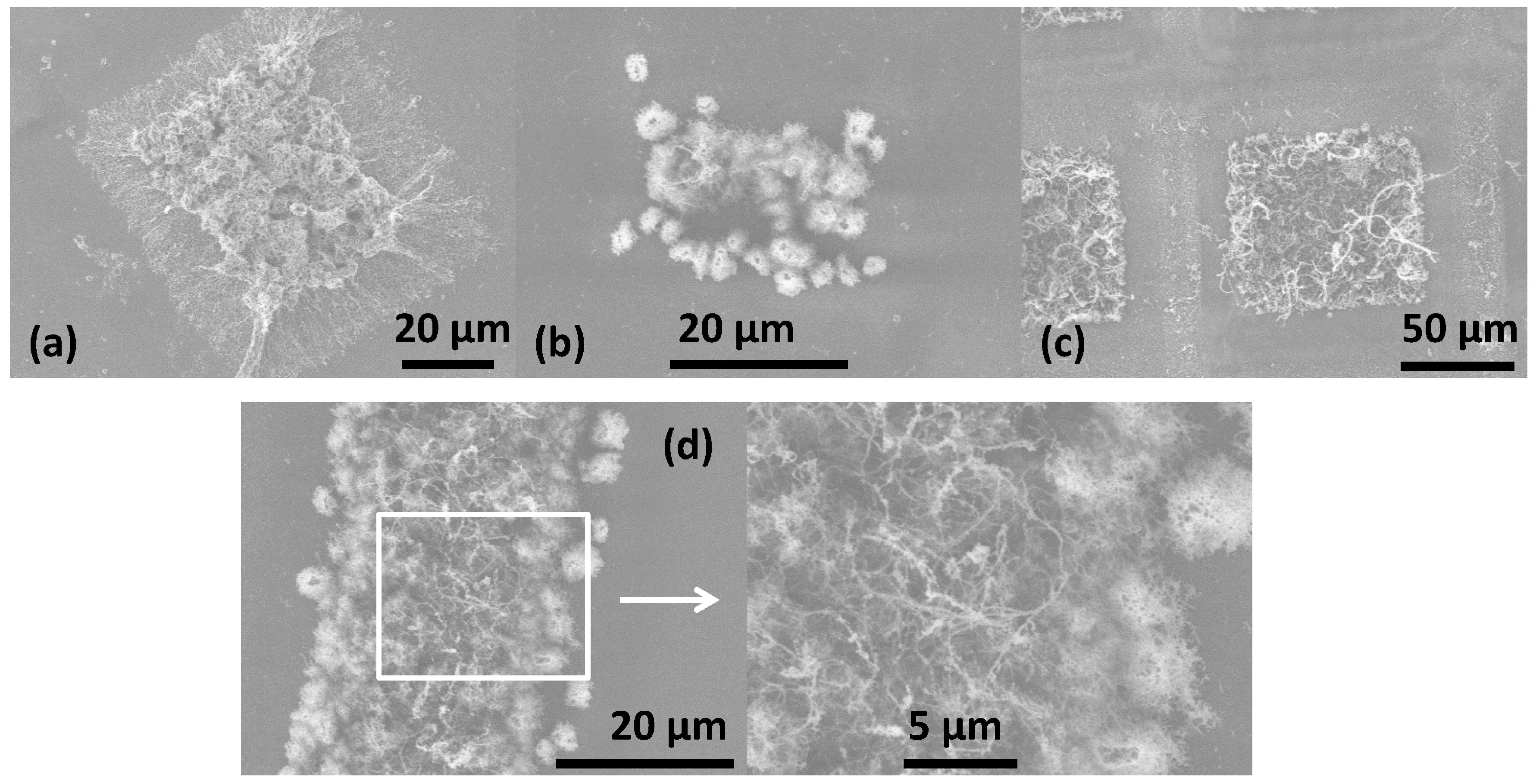
| Parameters for comparison | Selective CVD process | Laser patterning | Dry micro-electro-discharge |
|---|---|---|---|
| “Etched” surface resolution | Depends on the pre-patterned catalyst resolution on the substrate | 10 µm (15 µm from [1] with a focus offset of ~800 µm) | Dependent on the electrode diameter and the discharge gap clearance
|
| Maximum surface | Several cm2 | Several cm2 | Several mm2 from [10,11] (dependent on the number of electrodes [12]) |
| CNT length limitation and the pattern resolution |
| ||
| Debris left after process | No debris | Less debris for the optimal average power (if too low: some etched CNT stay on the substrate in the etched areas; if too high: damage to the substrate) | Less debris with the reverse polarity [10,11] |
| Throughput | Not applicable | A few minutes for 5 mm2 | A few minutes for 5 mm2 |
| Ambient | Not applicable | Process in ambient air | Ambient air (from [10]) N2–O2 or SF6–O2 (from [11]) |
| Constraints | Knowledge of the pattern before the process | The parameters depend on the CNT density and the brush height | High dependence on the electrode dimension |
3. Results and Discussion
3.1. Thermal Preliminary Measurements
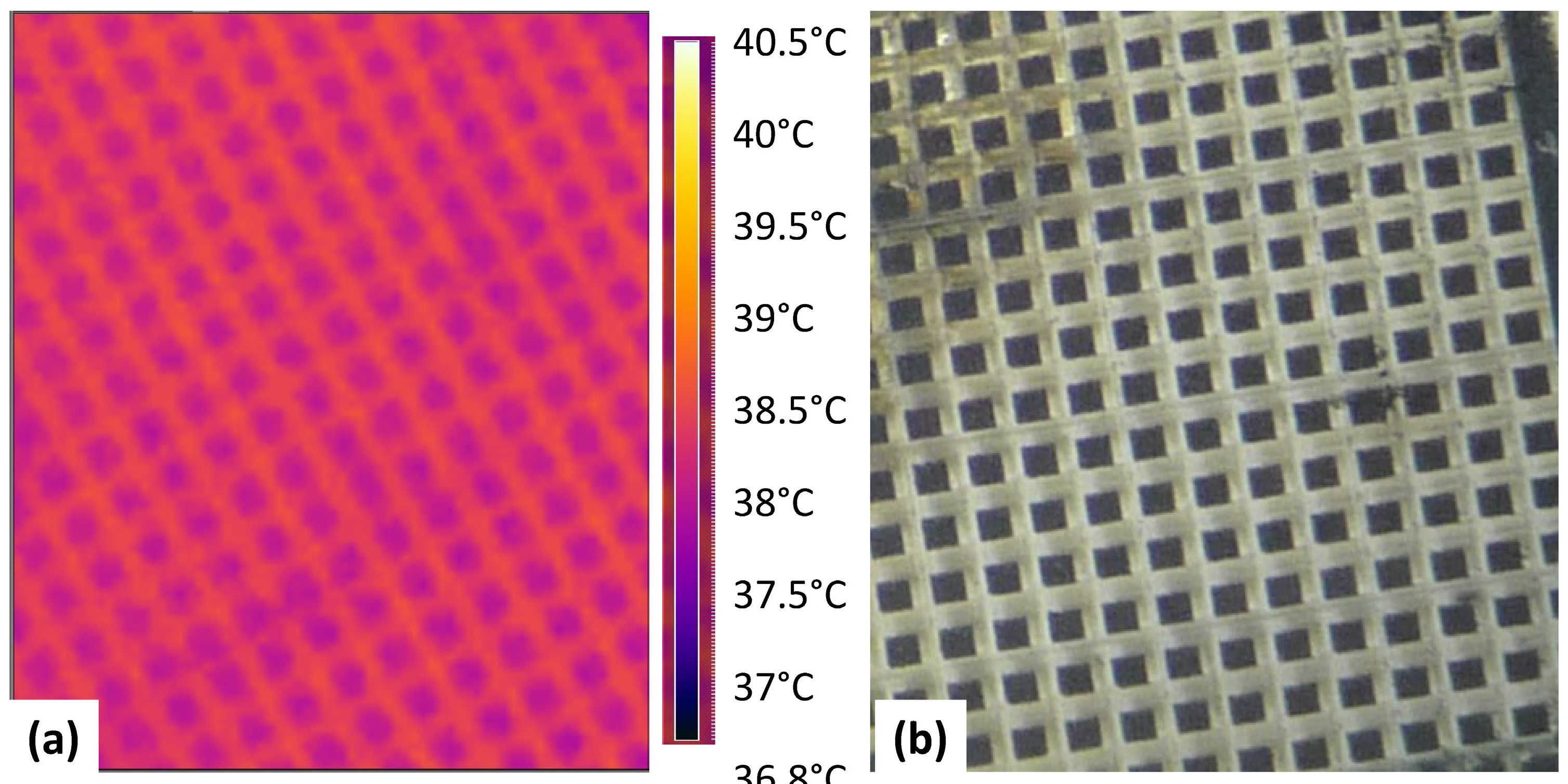
3.2. EM Characterization
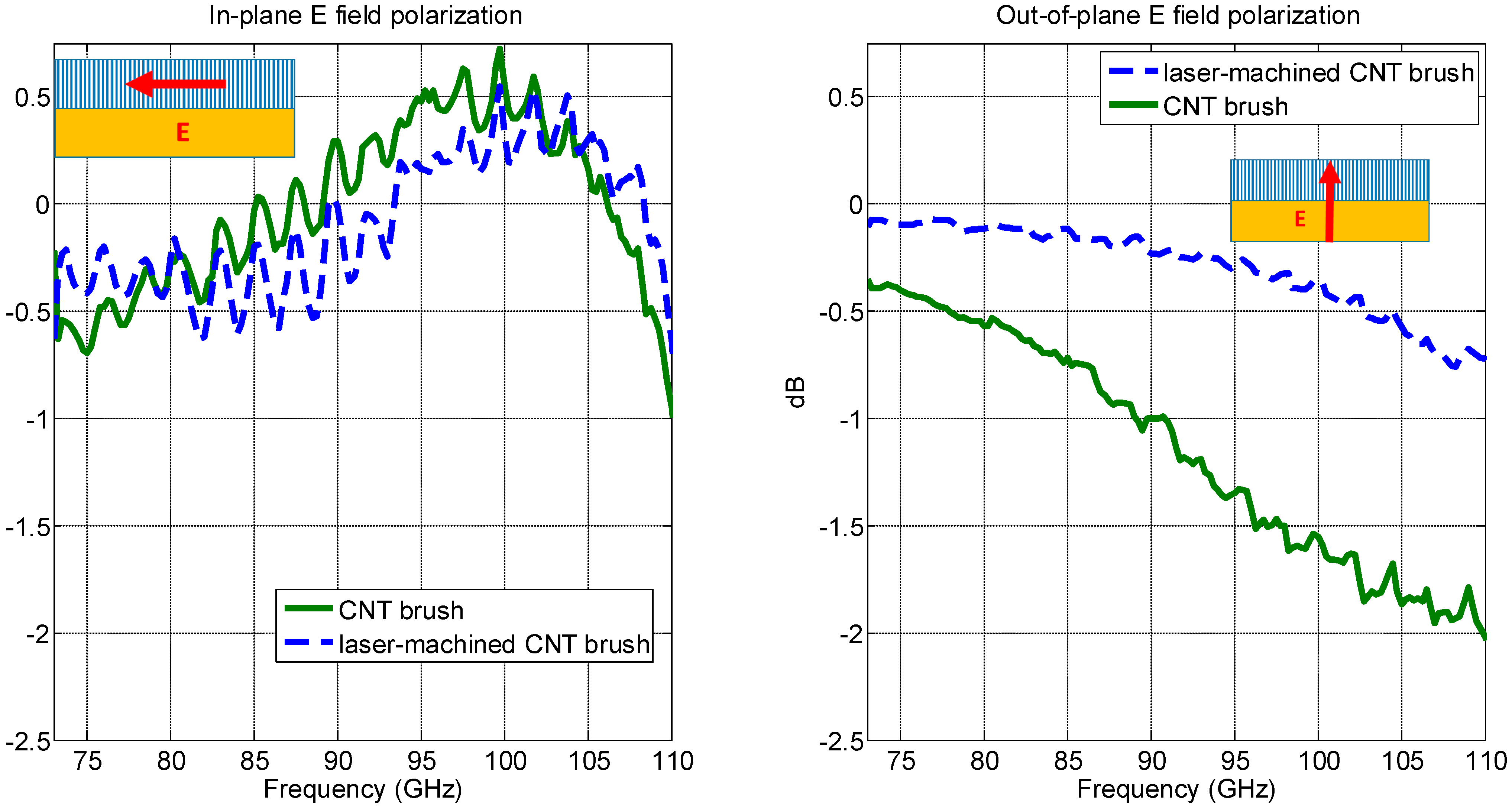

4. Conclusions
Acknowledgments
Author Contributions
Conflicts of Interest
References
- Kordás, K.; Tóth, G.; Moilanen, P.; Kumpumäki, M.; Vähäkangas, J.; Uusimäki, A.; Vajtai, R.; Ajayan, P.M. Chip cooling with integrated carbon nanotube microfin architectures. Appl. Phys. Lett. 2007, 90, 123105. [Google Scholar]
- Qi, Z. Electromagnetic radiation of carbon nanotube array in microwave frequencies. In Proceedings of Asia-Pacific Microwave Conference, Yokohama, Japan, 12–15 December 2006; pp. 701–703.
- Huynen, I.; Quiévy, N.; Bailly, C.; Bollen, P.; Detrembleur, C.; Eggermont, S.; Molenberg, I.; Thomassin, J.M.; Urbanczyk, L.; Pardoen, T. Multifunctional hybrids for electromagnetic absorption. Acta Mater. 2011, 59, 3255–3266. [Google Scholar] [CrossRef]
- Emplit, A.; Tao, F.; Bailly, C.; Huynen, I. Novel family of broadband nanocomposite microwave absorbers with carbon nanotubes in solid polymer film. In Proceedings of European Microwave Conference, Nuremberg, Germany, 6–10 October 2013; pp. 778–781.
- Marconnet, A.M.; Yamamoto, N.; Panzer, M.A.; Wardle, B.L.; Goodson, K.E. Thermal conduction in aligned carbon nanotube-polymer nanocomposites with high packing density. ACS Nano 2011, 5, 4818–4825. [Google Scholar] [CrossRef] [PubMed]
- Tong, T.; Zhao, Y.; Delzeit, L.; Kashani, A.; Meyyappan, M.; Majumdar, A. Dense vertically aligned multiwalled carbon nanotube arrays as thermal interface materials. IEEE Trans. Compon. Packag. Manuf. Technol. 2007, 30, 92–100. [Google Scholar]
- Liu, X.; Tyler, T.; Starr, T.; Starr, A.F.; Jokerst, N.M.; Padilla, W.J. Taming the blackbody with infrared metamaterials as selective thermal emitters. Phys. Rev. Lett. 2011, 107, 045901. [Google Scholar] [CrossRef]
- Emplit, A.; Huynen, I. Carbon nanotubes arrays for coupled electromagnetic and thermal management in high power electronics: influence of microstructuration and stress investigated by IR thermography. In Proceedings of the Fourteenth Intersociety Conference on Thermal and Thermomechanical Phenomena in Electronic Systems, Orlando, FL, USA, 27 May–30 June 2014; pp. 1379–1384.
- Brun, C.; Franck, P.; Chow, W.L.; Coquet, P.; Baillargeat, D.; Tay, B.K. Horizontal and vertical carbon-nanotube-array-based antenna design. In Proceedings of European Microwave Conference, Nuremberg, Germany, 6–10 October 2013; pp. 377–380.
- Saleh, T.; Dahmardeh, M.; Bsoul, A.; Nojeh, A.; Takahata, K. High-precision dry micro-electro-discharge machining of carbon-nanotube forests with ultralow discharge energy. In Proceedings of IEEE 25th International Conference on Micro Electro Mechanical Systems (MEMS), Paris, France, 29 January–2 February 2012; pp. 259–262.
- Saleh, T.; Dahmardeh, M.; Nojeh, A.; Takahata, K. Dry micro-electro-discharge machining of carbon-nanotube forests using sulphur-hexafluoride. Carbon 2013, 52, 288–295. [Google Scholar]
- Sarwar, M.S.U.; Dahmardeh, M.; Nojeh, A.; Takahata, K. Batch-mode micropatterning of carbon nanotube forests using UV-LIGA assisted micro-electro-discharge machining. J. Mater. Process. Technol. 2014, 214, 2537–2544. [Google Scholar]
- He, Y.; Deng, H.; Jiao, X.; He, S.; Gao, J.; Yang, X. Infrared perfect absorber based on nanowire metamaterial cavities. Opt. Lett. 2013, 38, 1179–1181. [Google Scholar] [CrossRef] [PubMed]
- Franck, P.; Baillargeat, D.; Tay, B.K. Mesoscopic model for the electromagnetic properties of arrays of nanotubes and nanowires: A bulk equivalent approach. IEEE Trans. Nanotechnol. 2012, 11, 964–974. [Google Scholar] [CrossRef]
© 2014 by the authors; licensee MDPI, Basel, Switzerland. This article is an open access article distributed under the terms and conditions of the Creative Commons Attribution license (http://creativecommons.org/licenses/by/3.0/).
Share and Cite
Emplit, A.; Tooten, E.; Xhurdebise, V.; Huynen, I. Multifunctional Material Structures Based on Laser-Etched Carbon Nanotube Arrays. Micromachines 2014, 5, 756-765. https://doi.org/10.3390/mi5030756
Emplit A, Tooten E, Xhurdebise V, Huynen I. Multifunctional Material Structures Based on Laser-Etched Carbon Nanotube Arrays. Micromachines. 2014; 5(3):756-765. https://doi.org/10.3390/mi5030756
Chicago/Turabian StyleEmplit, Aline, Ester Tooten, Victor Xhurdebise, and Isabelle Huynen. 2014. "Multifunctional Material Structures Based on Laser-Etched Carbon Nanotube Arrays" Micromachines 5, no. 3: 756-765. https://doi.org/10.3390/mi5030756
APA StyleEmplit, A., Tooten, E., Xhurdebise, V., & Huynen, I. (2014). Multifunctional Material Structures Based on Laser-Etched Carbon Nanotube Arrays. Micromachines, 5(3), 756-765. https://doi.org/10.3390/mi5030756




